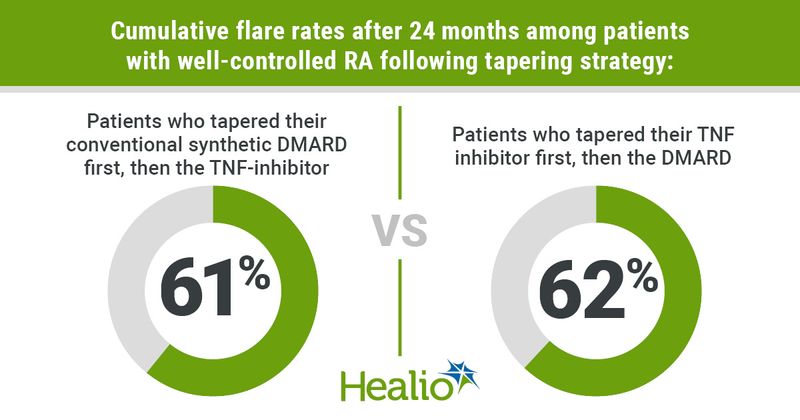Tapering order of TNF inhibitors, DMARDs does not impact RA outcomes
The sequence of drug tapering — DMARD followed by the TNF inhibitor, or the TNF inhibitor followed by the DMARD — does not impact flare rate or disease activity in patients with rheumatoid arthritis, according to data in Annals of the Rheumatic Diseases.
“With the possibility to taper medication, disease-modifying antirheumatic drugs-free remission is suggested as a preferred ultimate goal,” Elise van Mulligen, a PhD student at Erasmus MC, in Rotterdam, the Netherlands, told Healio Rheumatology. “However, there is not much information on reaching DFR for established RA patients.”

To analyze the clinical effectiveness of two different tapering strategies over a period of 2 years, van Mulligen and colleagues conducted a multicenter, single-blinded randomized controlled trial. Participants included 189 patients with RA who had been well-controlled for at least 3 consecutive months — defined as a Disease Activity Score of 2.4 or less in 44 joints and a swollen joint count of 1 or fewer — achieved through a conventional synthetic DMARD and a TNF inhibitor.
Among the participants, 94 were randomly assigned to gradually tapering their DMARD first, following by the TNF inhibitor, while the remaining 95 gradually tapered their TNF inhibitor first and then the DMARD. The primary outcome was the number of disease flares. Secondary outcomes included DMARD-free remission, Disease Activity Score, Health Assessment Questionnaire Disability Index and radiographic progression.

According to the researchers, the cumulative flare rates after 24months were 61% among the DMARD-first tapering group (95% CI, 50% to 71%) and 62% in patients who tapered their TNF inhibitor first (95% CI, 52% to 72%). Participants in the DMARD-first group were more often able to go through the entire tapering protocol, and reached DMARD-free remission more often (P = .07), compared with those who tapered their TNF inhibitor first. Mean Disease Activity Score and Health Assessment Questionnaire Disability Index over time, as well as radiographic progression, did not differ between the two groups.
“Approximately 61% of the patients had a flare within 2 years of follow-up while tapering their medication,” van Mulligen said. “In total, 15% of the established RA population was able to reach DFR. With our research we have shown that the order of tapering csDMARDs or TNF-inhibitors does not affect flare rates and that DFR might also be a relevant outcome for an established RA population.”
“DMARD-free remission is also a possible outcome in an established RA population,” she added. “Since the order of tapering was not affecting flare rates, disease activity, or physical functioning, we advise to taper the TNF-inhibitor first because of financial arguments.”
